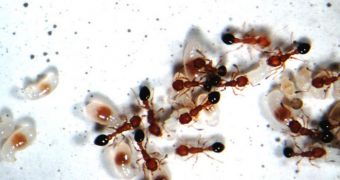Biologists know that ants are just as vulnerable as we are to infections from fungi, parasites and bacteria. The small insects also have immune systems, but one major difference from humans is that their colony is their immunity, not the single individual. In a series of new studies, researchers have determined that ant colonies which interbreed often tend to exhibit much lower levels of immunity. This in turn exposes their colony to more infections, and increases the chances of them being wiped out entirely, ScienceNow reports.
One of the most commonly-used defense mechanisms that ants employ to rid themselves of unwanted intruders is coating their nests with antibacterial resin. An additional habit is for worker ants to remove sick larvae from the nests, a behavior similar to that recorded in bees, and strikingly similar to the one that human white blood cells employ in removing pathogens from our bodies. The new investigation essentially determined that inbred colonies tend to exhibit lower diseases detection rates, as well as a lower speed of infected larvae removal.
“We think these inbred ants cannot smell the pathogen and have to rely on some other signal coming from the larvae once they are really infected,” says German researcher Sylvia Cremer, who is an evolutionary biologist at the University of Regensburg. She was also the leader of the team that conducted the investigation, which is detailed in the May 5 issue of the esteemed scientific journal Proceedings of the Royal Society B. The ant experiments were conducted in the group's lab, where two colonies of the species Cardiocondyla obscurior were compared.
The first one featured queens that were only allowed to mate with their brothers, whereas queens from the second one were allowed access to more diverse genetic material. The Metarhizium anisopliae fungus was then used to infect the larvae of both nests, after 10 generations of ants had been born. By observing the behavior of the ants, the researchers learned that the non-inbred ants were able to remove larvae even before they showed early signs of infection, whereas the inbred ants took 24 extra hours to do the same. Cremer hypothesizes that the mechanisms which allow ants to detect infected larvae are actually disabled by inbreeding.

 14 DAY TRIAL //
14 DAY TRIAL //